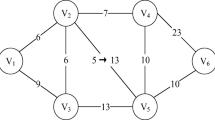Abstract
The mining and analysis of social networks can bring significant economic and social benefits. However, it also poses a risk of privacy leakages. Differential privacy is a de facto standard to prevent such leaks, but it suffers from the high sensitivity of query functions. Although projection is a technique that can reduce this sensitivity, existing methods still struggle to maintain a satisfactory level of sensitivity in query functions. This results in lower data utility and an inevitable risk of privacy leakage. To prevent the disclosure of user privacy, we need to significantly reduce the sensitivity of the query functions and minimize the error of the projected values with respect to the original values. To address this issue, we first explore the influence of mapping and projection on reducing the sensitivity of query functions. We then propose a Probability Mapping (PM) algorithm, based on multi-armed bandit, which however tends to generate mapped graphs with a wide range of degrees and containing considerable nodes with high degrees. Thus, we develop a new Probability Projection (PP) algorithm to overcome these weaknesses. Finally, we propose four histogram publishing algorithms built upon PM and PP, namely PMTC, PPTC, PMCTC and PPCTC. Extensive experimental results on three different sized datasets show that PM and PP not only retain more edge information and reduce the error but also improve the data availability.
Access this chapter
Tax calculation will be finalised at checkout
Purchases are for personal use only
Similar content being viewed by others
References
Sweeney, L.: K-anonymity: a model for protecting privacy. Int. J. Uncertain. Fuzziness Knowl.-Based Syst. 10(05), 557–570 (2002). https://doi.org/10.1142/S0218488502001648
Machanavajjhala, A., Gehrke, J., Kifer, D., Muthuramakrishnan, V.: L-diversity: privacy beyond k-anonymity. ACM Trans. Knowl. Discov. Data (TKDD) 1(1), 1–52 (2007). https://doi.org/10.1145/1217299.1217302
Li, N., Li, T., Venkatasubramanian, S.: T-Closeness: privacy beyond k-anonymity and l-diversity. In: 2007 IEEE 23rd International Conference on Data Engineering, pp. 106–115 (2006)
Xiao, X., Tao, Y.: M-invariance: towards privacy preserving re-publication of dynamic datasets. In: Proceedings of the 2007 ACM SIGMOD International Conference on Management of Data, pp. 689–700 (2007)
Jiang, H., Pei, J., Yu, D., Yu, J., Gong, B., Cheng, X.: Applications of differential privacy in social network analysis: a survey. IEEE Trans. Knowl. Data Eng. 35(1), 108–127 (2021). https://doi.org/10.1109/TKDE.2021.3073062
Dwork, C.: Differential privacy. In: Bugliesi, M., Preneel, B., Sassone, V., Wegener, I. (eds.) Automata, Languages and Programming. ICALP 2006. LNCS, vol. 4052, pp. 1–12. Springer, Berlin, Heidelberg (2006). https://doi.org/10.1007/11787006_1
Lv, T., Li, H., Tang, Z., Fu, F., Cao, J., Zhang, J.: Publishing triangle counting histogram in social networks based on differential privacy. Secur. Commun. Netw. 2021, 1–16 (2021). https://doi.org/10.1155/2021/7206179
Zhou, N., Long, S., Liu, H.: Structure-attribute social network graph data publishing satisfying differential privacy. Symmetry 14(12), 2531–2541 (2022)
Huang, H., Zhang, D., Xiao, F., Wang, K., Gu, J., Wang, R.: Privacy-preserving approach PBCN in social network with differential privacy. IEEE Trans. Netw. Serv. Manag. 17(2), 931–945 (2020). https://doi.org/10.1109/TNSM.2020.2982555
Gao, T., Li, F.: Protecting social network with differential privacy under novel graph model. IEEE Access 8(23), 185276–185289 (2020)
Day, W.Y., Li, N., Min, L.: Publishing graph degree distribution with node differential privacy. In: Proceedings of the 2016 International Conference on Management of Data, pp. 123–138 (2016)
Zhang, Y., Wei, J., Li, J.: Graph degree histogram publication method with node-differential privacy. J. Comput. Res. Dev. 56(3), 508–520 (2019). https://doi.org/10.7544/issn1000-1239.2019.20170886
Liu, G., Ma, X., Li, W.: Publishing node strength distribution with node differential privacy. IEEE Access 8(23), 217642–217650 (2020)
Ding, X., et al.: Differential private triangle counting in large graphs. IEEE Trans. Knowl. Data Eng. 34(11), 5278–5292 (2021). https://doi.org/10.1109/TKDE.2021.3052827
Sofya, R., Adam, S.: Efficient Lipschitz extensions for high-dimensional graph statistics and node private degree distributions (2015). arXiv preprint arXiv:1504.07912
Wu, X., Zhang, Y., Shi, M., Li, P., Li, R., Xiong, N.: An adaptive federated learning scheme with differential privacy preserving. Futur. Gener. Comput. Syst. 127(1), 362–372 (2022). https://doi.org/10.1016/j.future.2021.09.015
Odeyomi, O.T.: Differential privacy in social networks using multi-armed bandit. IEEE Access 8, 11817–11829 (2022)
Jure, L., Andrej, K.: June 2014. http://snap.stanford.edu/data
Acknowledgement
This research was funded by NSFC under Grant 61572170, Natural Science Foundation of Hebei Province under Grant F2021205004, Science Foundation of Returned Overseas of Hebei Province Under Grant C2020342, and Key Science Foundation of Hebei Education Department under Grant ZD2021062.
Author information
Authors and Affiliations
Corresponding authors
Editor information
Editors and Affiliations
Rights and permissions
Copyright information
© 2024 The Author(s), under exclusive license to Springer Nature Singapore Pte Ltd.
About this paper
Cite this paper
Li, Q., Wang, Y., Wang, F., Tan, Z., Wang, C. (2024). A Probability Mapping-Based Privacy Preservation Method for Social Networks. In: Wang, G., Wang, H., Min, G., Georgalas, N., Meng, W. (eds) Ubiquitous Security. UbiSec 2023. Communications in Computer and Information Science, vol 2034. Springer, Singapore. https://doi.org/10.1007/978-981-97-1274-8_19
Download citation
DOI: https://doi.org/10.1007/978-981-97-1274-8_19
Published:
Publisher Name: Springer, Singapore
Print ISBN: 978-981-97-1273-1
Online ISBN: 978-981-97-1274-8
eBook Packages: Computer ScienceComputer Science (R0)




